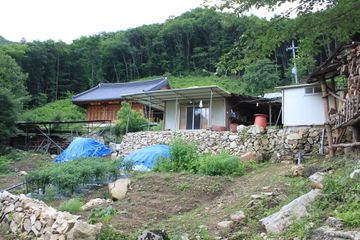함양 백용성선사 화과원 유허지
| 함양 백용성선사 화과원 유허지 Hwagwawon Historic Site Related to Buddhist Monk Baek Yong-seong, Hamyang |
|
 함양 백룡성선사 화과원 유허지, 국가문화유산포털, 문화재청. |
|
| 대표명칭 | 함양 백용성선사 화과원 유허지 |
|---|---|
| 영문명칭 | Hwagwawon Historic Site Related to Buddhist Monk Baek Yong-seong, Hamyang |
| 한자 | 咸陽 白龍城禪師 華果院 遺墟址 |
| 주소 | 경상남도 함양군 백전면 백운리 50 |
| 지정번호 | 경상남도 기념물 제229호 |
| 지정일 | 2000년 8월 31일 |
| 분류 | 유적건조물/인물사건/인물기념 |
| 수량/면적 | 13709 |
| 웹사이트 | 함양 백룡성선사 화과원 유허지, 국가문화유산포털, 문화재청. |
|
|
|
해설문
국문
백용성 선사 화과원 유허지는 3.1운동 당시 민족대표 33인의 한 사람으로 독립 운동가인 백용성(白龍城) 선사가 일제 강점기 때 독립운동 자금을 대기 위해 개척한 농장이다.
참선과 농사를 함께 하는 선농불교(禪農佛敎)를 제창했던 백용성은 3·1운동으로 인해 3년간의 옥살이 후 서울 대각사에서 대각교(大覺敎)를 만들어서 새로운 불교 운동과 국민 계몽 운동을 펼쳤다. 선사의 법명은 진종(震鍾)이고 법호는 용성이다.
화과원 유허지는 백운산의 8부 능선에 위치하며 현재 이곳에는 법당 터, 선방 터 등 9개의 건물터와 축대, 석조물, 가마터 등이 남아 있고 고목이 된 배나무 등의 과일나무가 주변에 남아 있다.
영문
Hwagwawon Historic Site Related to Buddhist Monk Baek Yong-seong, Hamyang
This is the site of a farm called Hwagwawon which was cultivated by Baek Yong-seong (1864-1940), a Buddhist monk and independence activist during the Japanese colonial period (1910-1945). Baek was named one of the 33 national representatives of the March First Independence Movement of 1919.
Baek preached a concept of combining meditation with farming. He cultivated patches of forest and wasteland in Baegunsan Mountain and planted fruit trees there. It made the temple economically self-reliant and allowed the monks to practice meditation through farming. In addition, the profits from the sale of produce harvested here helped raise funds for the independence movement, Buddhist reforms, and public education campaigns.
Nine building sites were discovered here, including worship halls and meditation rooms, as well as retaining walls and a kiln site. There are also pear, chestnut, and persimmon trees said to have been planted at the time when the farm was established.
영문 해설 내용
이곳은 일제강점기의 승려이자 독립운동가인 백용성(1864-1940)이 개척한 화과원이라는 농장이 있던 자리다. 백용성은 3·1운동을 주도한 민족대표 33인 중 한 사람이기도 하다.
백용성은 참선과 농사를 함께 하는 ‘선농불교’를 제창하였으며, 백운산의 산림과 황무지를 개간하여 과수를 심었다. 이를 통해 사원을 경제적으로 자립하게 하고 스님들이 스스로 농사를 지으면서 수행할 수 있게 하였다. 또한 이곳에서 수확한 농작물을 판매한 수익금으로 독립 자금을 조달하였으며, 불교개혁과 국민 계몽 운동을 펼쳤다.
현재 이곳에는 법당 터와 선방 터 등 9개의 건물 터와 축대, 가마터 등이 남아 있고, 최초 설립 당시에 심었다고 전해지는 배나무, 밤나무, 감나무 등이 있다.
문맥요소
Nodes
Links
참고자료
- 함양백룡성선사화과원유허지, 문화재청 국가문화유산포털. http://www.heritage.go.kr/heri/cul/culSelectDetail.do?ccbaCpno=2333802290000
- 함양 백룡성선사 화과원 유허지, 디지털함양문화대전, 한국학중앙연구원. http://hamyang.grandculture.net/hamyang/toc/GC07200454
- “3·1운동 100년 경남의 독립운동 - (18) 함양”, 경남신문, 2020.03.10. http://www.knnews.co.kr/news/articleView.php?idxno=1321150